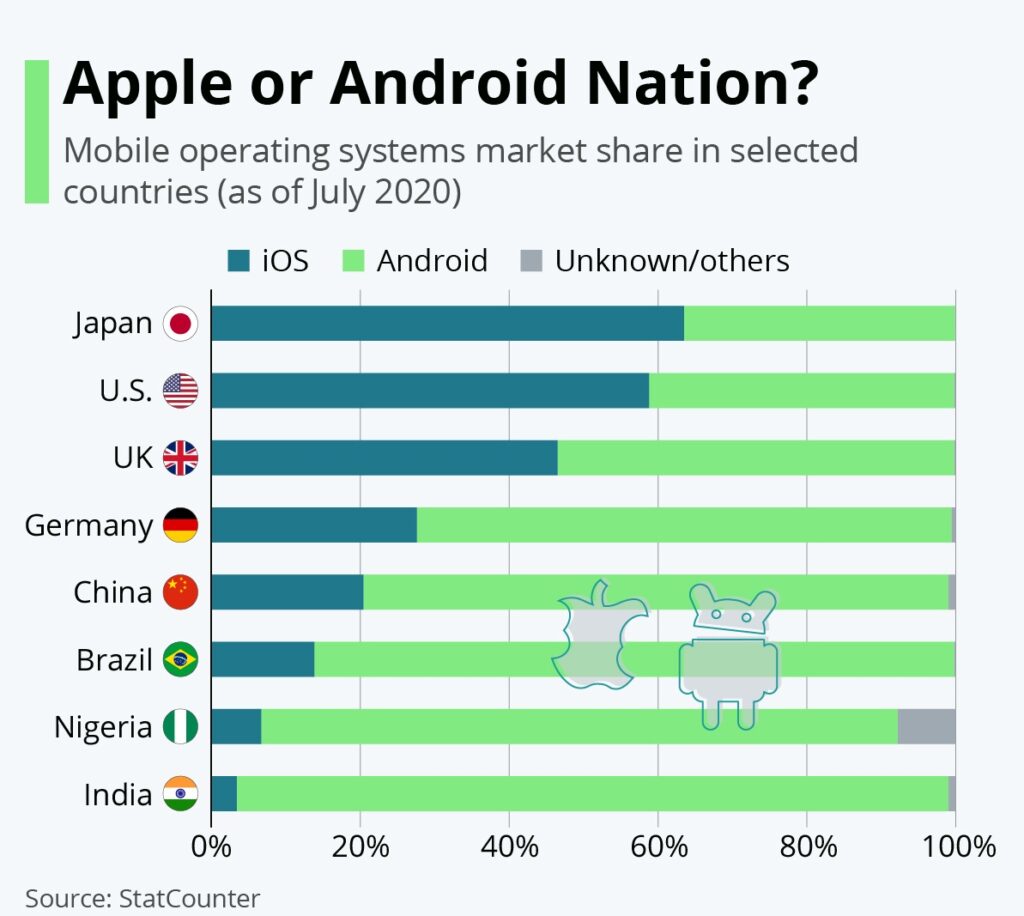Android vs. iOS: User Demographics takes center stage, delving into the distinct characteristics of users who embrace these two dominant mobile operating systems. This exploration unveils the unique preferences, behaviors, and demographics that shape the mobile landscape, providing valuable insights for businesses and developers seeking to engage with their target audiences effectively.
The battle for mobile supremacy continues, with Android and iOS dominating the market. This article examines the distinct demographics of users on each platform, exploring factors such as age, gender, income, and occupation. By understanding these differences, we can gain a deeper understanding of the unique needs and preferences of each user base, ultimately leading to more targeted and successful marketing strategies.
Market Share and Growth
The mobile operating system (OS) market is dominated by two major players: Android and iOS. Android, developed by Google, is an open-source platform, while iOS is a proprietary operating system developed by Apple. These platforms have witnessed significant growth and evolution over the years, with their market share and user demographics constantly shifting.
Market Share
Android currently holds the largest market share globally, with a dominant position in many regions. According to StatCounter GlobalStats, as of December 2023, Android holds a global market share of approximately 71.93%, while iOS accounts for 27.19%. This dominance is particularly pronounced in emerging markets, where Android devices are more affordable and accessible.
However, iOS retains a strong presence in developed markets like the United States, Canada, and Europe, where Apple products enjoy high brand loyalty and premium pricing.
In this topic, you find that Android vs. iOS: Which is Better for Gaming? is very useful.
Growth Rate, Android vs. iOS: User Demographics
Both Android and iOS have experienced impressive growth over the past few years. Android’s growth rate has been driven by its open-source nature, allowing manufacturers to create a wide range of devices at various price points. On the other hand, iOS has maintained steady growth due to its focus on user experience, seamless integration across Apple devices, and a strong app ecosystem.
While Android has a higher global market share, iOS boasts a higher average revenue per user (ARPU), indicating a more loyal and engaged user base.
Adoption Rates by Age Groups
The adoption rates of Android and iOS vary across different age groups. Younger generations tend to favor Android, driven by its affordability and customization options. Older generations, particularly in developed markets, often prefer iOS for its ease of use, intuitive interface, and perceived security.
This trend can be attributed to factors such as familiarity with Apple products, preference for a more streamlined experience, and higher disposable income among older demographics.
Obtain direct knowledge about the efficiency of Android vs. iOS: Price and Value through case studies.
Factors Driving Growth
Several factors contribute to the growth of both platforms. For Android, key drivers include:
- Open-source nature, enabling a diverse range of devices and price points.
- Wide availability of affordable devices, particularly in emerging markets.
- Regular software updates and feature enhancements.
- Strong integration with Google services and apps.
iOS growth is driven by:
- Seamless integration across Apple devices and services.
- Focus on user experience, design, and security.
- High-quality app ecosystem with a curated selection.
- Strong brand loyalty and premium pricing.
User Demographics
Understanding the demographics of Android and iOS users provides valuable insights into their preferences, behaviors, and purchasing power. These demographics can vary significantly based on factors such as age, gender, income, education, and occupation.
You also can investigate more thoroughly about The Future of Sustainable Battery Production to enhance your awareness in the field of The Future of Sustainable Battery Production.
Key Demographics
Android users tend to be younger, more diverse, and have a wider range of income levels compared to iOS users. This can be attributed to the availability of Android devices at various price points, catering to a broader market. iOS users, on the other hand, are often associated with higher income levels, higher education attainment, and a more affluent demographic.
This is due to Apple’s premium pricing strategy and the perceived status associated with its products.
Regional Differences
The demographics of Android and iOS users can also vary across different countries and regions. In emerging markets, Android holds a dominant position due to its affordability and availability. In developed markets, iOS enjoys a stronger presence, particularly among affluent demographics.
For instance, in the United States, iOS has a higher market share than Android, reflecting the higher disposable income and preference for premium devices among American consumers.
Obtain a comprehensive document about the application of Android vs. iOS: Key Differences Explained that is effective.
Reasons for Demographic Differences
The differences in user demographics between Android and iOS can be attributed to several factors, including:
- Price:Android devices offer a wider range of price points, making them accessible to a broader demographic. iOS devices, with their premium pricing, tend to attract users with higher disposable income.
- Brand Perception:Apple products are often associated with prestige and status, appealing to users seeking a premium brand experience. Android devices, on the other hand, are perceived as more practical and value-driven.
- Ecosystem:Apple’s ecosystem, with its seamless integration across devices and services, appeals to users seeking a unified experience. Android’s open-source nature allows for greater customization but can lead to a more fragmented experience.
- Cultural Factors:Cultural factors, such as social status, technological adoption, and purchasing power, can also influence user preferences for Android or iOS.
User Preferences and Behavior
Understanding user preferences and behaviors is crucial for app developers, marketers, and businesses targeting mobile users. These preferences can vary significantly between Android and iOS users, influencing their app usage, content consumption, and online shopping habits.
App Usage and Content Consumption
Android users tend to engage with a wider range of apps, exploring different categories and experimenting with new experiences. This can be attributed to the vast app selection available on the Google Play Store and the greater openness of the Android platform.
iOS users, on the other hand, often prefer a more curated app experience, focusing on high-quality apps and services. This is reflected in the Apple App Store’s stricter app review process and the emphasis on user experience within the iOS ecosystem.
Obtain access to How to Choose a Phone with the Right Battery for You to private resources that are additional.
Time Spent on Devices and App Usage Frequency
Research suggests that Android users spend more time on their devices compared to iOS users. This can be attributed to factors such as the wider availability of budget-friendly Android devices, making them more accessible for everyday use. iOS users, with their premium devices and focus on user experience, might engage in more focused and specific tasks, leading to shorter but more frequent app usage sessions.
Factors Influencing Preferences and Behaviors
Several factors influence the user preferences and behaviors of Android and iOS users, including:
- Device Type:The type of device used, whether a smartphone, tablet, or smartwatch, can influence app usage patterns and content consumption habits.
- Age and Demographics:Younger generations tend to be more tech-savvy and engage with a wider range of apps, while older generations might prefer simpler and more intuitive apps.
- Cultural Factors:Cultural norms and societal expectations can shape user preferences and behaviors, influencing app usage and content consumption.
- Personal Interests:Individual interests and hobbies can significantly influence app usage patterns, leading to preferences for specific categories or apps.
Device Usage and Features
The choice of device and the preferred features can vary significantly between Android and iOS users. These differences stem from factors such as screen size, battery life, data usage, and the availability of specific functionalities.
Notice The Importance of Battery Safety for recommendations and other broad suggestions.
Device Usage Patterns
Android users often prefer larger screen sizes, particularly in emerging markets where devices are used for a wide range of tasks, including media consumption and gaming. iOS users, on the other hand, tend to favor smaller and more compact devices, prioritizing portability and ease of use.
This preference is reflected in Apple’s focus on design and user experience, emphasizing sleek and ergonomic devices.
Battery Life and Data Usage
Battery life and data usage can also influence device preferences. Android devices, with their wide range of processors and battery capacities, offer a broader spectrum of options for users with varying needs. iOS devices, with their focus on efficiency and optimized software, generally offer good battery life and data management capabilities.
You also can investigate more thoroughly about Android vs. iOS: A Comprehensive Comparison to enhance your awareness in the field of Android vs. iOS: A Comprehensive Comparison.
However, the specific battery performance and data usage can vary depending on the individual device model and usage patterns.
Popular Features and Functionalities
The popularity of specific features and functionalities can differ between Android and iOS. Android users often appreciate the flexibility and customization options offered by the platform, such as the ability to change launchers, widgets, and themes. iOS users value the seamless integration across Apple devices, the intuitive interface, and the focus on security and privacy.
Specific features like camera capabilities, multitasking options, and security features can also vary in popularity between the two platforms.
Factors Influencing Device and Feature Choice
Several factors influence the choice of device and features between Android and iOS users, including:
- Price:The price point of the device is a significant factor, particularly for budget-conscious users. Android offers a wider range of devices at various price points, while iOS devices tend to be more expensive.
- Brand Loyalty:Users who are loyal to a particular brand, such as Apple or Samsung, are more likely to stick with their preferred platform.
- Personal Preferences:Individual preferences for screen size, battery life, design, and specific features can influence the choice of device and operating system.
- Ecosystem:The integration of devices and services within an ecosystem, such as Apple’s or Google’s, can influence user preferences for a particular platform.
App Ecosystem and Content

The app ecosystem and content availability play a crucial role in shaping user experiences and influencing app usage patterns. Both Android and iOS offer vast app ecosystems, but there are significant differences in terms of app availability, quality, and pricing.
App Availability and Quality
The Google Play Store, with its open-source nature, offers a wider selection of apps compared to the Apple App Store. However, the App Store has a stricter app review process, resulting in a more curated selection of high-quality apps. This can lead to a more consistent and user-friendly experience for iOS users, but it can also limit the availability of niche or experimental apps.
Investigate the pros of accepting Android vs. iOS: Customization Options in your business strategies.
Content Consumption Patterns
Android and iOS users exhibit distinct content consumption patterns. Android users, with their diverse demographics and wide range of devices, engage with a broader range of content, including music streaming, video watching, gaming, and social media. iOS users, with their focus on premium experiences, often prefer high-quality streaming services, curated content platforms, and exclusive apps.
Differences in App Ecosystems and Content Preferences
The differences in app ecosystems and content preferences between Android and iOS can be attributed to several factors, including:
- App Review Process:The App Store’s stricter app review process ensures a higher quality of apps, while the Play Store’s more open approach allows for a wider range of apps, including niche or experimental ones.
- User Demographics:Android users, with their diverse demographics, engage with a wider range of content, while iOS users, with their more affluent demographic, often prefer premium experiences and exclusive content.
- Platform Philosophy:Apple’s focus on user experience and a curated app ecosystem leads to a more streamlined and consistent experience, while Android’s open-source nature allows for greater flexibility and customization.
User Engagement and Satisfaction
User engagement and satisfaction are key metrics for measuring the success of a mobile operating system. Both Android and iOS strive to provide engaging user experiences, but there can be differences in how users interact with the platforms and their overall satisfaction levels.
Enhance your insight with the methods and methods of Battery Replacement: DIY vs. Professional Repair.
Engagement Levels and Satisfaction Ratings
Studies have shown that Android users tend to have higher engagement levels, spending more time on their devices and using a wider range of apps. This can be attributed to the open-source nature of Android, allowing for greater customization and flexibility.
Browse the multiple elements of Android vs. iOS: Which is Better for Photography? to gain a more broad understanding.
iOS users, while exhibiting lower engagement levels, often report higher satisfaction ratings, attributing it to the seamless integration across Apple devices, the intuitive interface, and the focus on security and privacy.
Factors Influencing Engagement and Satisfaction
Several factors influence user engagement and satisfaction on both platforms, including:
- App Performance:Smooth app performance, fast loading times, and minimal crashes are essential for a positive user experience.
- User Interface:An intuitive and user-friendly interface, with easy navigation and clear information, contributes to a positive user experience.
- Customer Support:Responsive and helpful customer support can resolve issues and enhance user satisfaction.
- Security and Privacy:Robust security measures and privacy protection are crucial for building trust and user satisfaction.
Reasons for Differences in Engagement and Satisfaction
The differences in user engagement and satisfaction between Android and iOS can be attributed to several factors, including:
- Platform Philosophy:Android’s open-source nature allows for greater customization and flexibility, leading to higher engagement levels. iOS’s focus on user experience and a curated app ecosystem results in higher satisfaction ratings.
- User Demographics:Android users, with their diverse demographics, may engage with the platform in different ways, while iOS users, with their more affluent demographic, may have higher expectations for user experience and satisfaction.
- App Ecosystem:The availability of a wider range of apps on Android can lead to higher engagement levels, while the curated app ecosystem on iOS can result in higher satisfaction ratings.
Conclusion
The landscape of mobile operating systems is a dynamic one, constantly evolving as user preferences and technology advance. Understanding the demographics of Android and iOS users is crucial for anyone seeking to engage with this vast and influential market. By recognizing the distinct characteristics of each user base, businesses and developers can tailor their strategies to effectively reach and engage with their target audiences.
Expert Answers: Android Vs. IOS: User Demographics
What are the key differences in app usage between Android and iOS users?
Android users tend to use a wider variety of apps, including more free and open-source options, while iOS users often favor premium apps and services.
How do the demographics of Android and iOS users differ in terms of age?
Android users tend to be younger than iOS users, with a larger proportion of users under the age of 35. iOS users, on the other hand, have a higher concentration of users over the age of 45.
What are the main factors driving the growth of Android and iOS platforms?
Android’s growth is driven by its open-source nature, affordability, and wide device availability. iOS, on the other hand, benefits from its strong brand recognition, seamless integration with Apple’s ecosystem, and focus on user experience.










